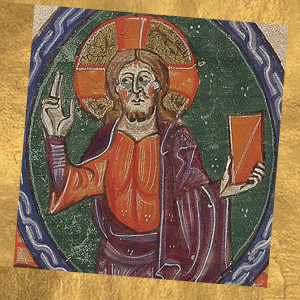Saint Philomena
Philomena, a Christian martyr
Devotion to Saint Philomena, and all the questions surrounding her identity, have their origin at Rome on 25 May 1802, during excavations in the Catacombs of Priscilla on the Via Salaria, when the bones of a young girl of thirteen were discovered in a vial containing a liquid believed to be the blood of the Saint. The space was closed by three terracotta tiles on which was inscribed the words LUMENA / PAX TE / CUM FI. It was believed that the tiles had been inadvertently inverted, so that the inscription should have read: PAX TECUM FILUMENA, that is, “Peace be with you, Philomena.” The different images that were inscribed on the tiles -- including a palm branch and a lance -- were enough to attribute the bones within the tomb to a Christian martyr of the early ages. At the time, it was believed that the greater part of the remains found in the Catacombs came from the persecutions of the first centuries of the Christian era.
The relics and the miracles at Mugnano del Cardinale
These were the relics that were later brought to the village of Mugnano del Cardinale, in Avellino, to the church dedicated to the Madonna delle Grazie, where they remain to this day. Here the first miracles were recorded by Father Francesco De Lucia, a priest of Nola, who had requested the relics from Rome. Moved by what was happening, the Pope at that time, Leo XII, sent the original terracotta tiles to the shrine at Mugnano.
It was in this context that the “Revelations” of Sr Maria Luisa de Gesù appeared, purporting to be a revelation of the life of Saint Philomena. The popularity of this work helped spread devotion to the saint throughout Europe and America. Noted personalities, including the Ven. Pauline-Marie Jaricot, the foundress of the Society of the Propagation of the Faith and the Living Rosary Association; and the sainted Cure d’Ars, John Vianney, received complete healing from illnesses through the intercession of Saint Philomena, and became fervent devotees.
Biography according to Sr Maria Luisa di Gesù
It was precisely the account of Sr Maria Luisa that revealed the story of Philomena. She affirmed that the story of Philomena’s life was recounted through a revelation of the saint by the Saint herself. According to the good sister, Philomena was a daughter of a Greek king who, along with his wife and family, converted to Christianity. At 13, Philomena consecrated herself to God and took a vow of perpetual virginity.
Around that time, the Roman Emperor Diocletian threatened war against her father. Her family was constrained to go to Rome to treat for peace. Seeing the beautiful young girl, the Emperor lusted after her. When she refused his advances, he subjected her to a series of tortures from which she was delivered by heavenly aid, until at last she was beheaded, and earned the palm of martyrdom. The symbols on her tomb in the catacombs -- two anchors, three arrows, a palm branch, and a flower -- were taken as the symbols of her martyrdom.
Later historians would cast doubt on the version of events related by Sr Maria Luisa. They claimed that the absence of the word “martyr” on the tiles spoke against her martyrdom; and it was discovered that the ampule thought to be filled with her blood instead contained perfumes typically used in the burials of the first Christians. Some suggested that the tiles covering her tomb had been re-used, and that the relics were not of Philomena at all. On account of these doubts, Philomena was removed from the calendar during the changes to the order of liturgical worship introduced in the wake of the Second Vatican Council during the 1960’s. But devotion to St Philomena remains.
Devotion remains
The “dear little saint” of the Curé d’Ars, as he called St Philomena, was also found a devout client in Saint Pio of Pietrelcina (Padre Pio). He called her the “little princess of Paradise,” and to those who dared question her existence, he replied that doubts were the fruit of the demon. Padre Pio said, “You can say that she was not called Philomena -- but this saint has worked miracles, and it was not the name that did them!”
To this day, Saint Philomena intercedes for many souls and the numerous faithful who visit her shrine to pray before her relics. She is considered the patroness and protectress of newlyweds; and she has often given the joy of motherhood to women who had been sterile.







